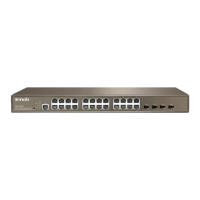User Guide
40
user B and user C to the other VLAN.
802.1Q VLAN
VLAN Tag:
As defined in IEEE 802.1Q, a four-byte VLAN tag is inserted after the DA&SA field to identify frames of
different VLANs.
(1) TPID: The 16-bit TPID field with a value of 0x8100 indicates that the frame is VLAN-tagged.
(2) Priority: The 3-bit priority field indicates the 802.1P priority of the frame (0-7).
(3) CFI: CFI is a 1-bit field, indicating whether the MAC address is encapsulated in the standard
format in different transmission media. A value of 0 indicates that MAC addresses are
encapsulated in the standard format. A value of 1 indicates that MAC addresses are
encapsulated in a non-standard format. For Ethernet switches, it is advisable to set this value to
0.
(4) VID: The 12-bit VLAN ID field identifies the VLAN which the frame belongs to. The VLAN ID
range is 0 to 4095. Because 0 and 4095 are reserved, a VLAN ID actually ranges from 1 to 4094.
802.1Q VLAN Port link type:
When creating the 802.1Q VLAN, you should set the link type for the port according to its connected
device. The link types of port including the following three types:
(1) Access: An access port belongs to only one VLAN. It is usually used to connect a PC.
(2) Trunk: A trunk port can carry multiple VLANs to receive and send traffic for them. Usually, ports
that connect switches are configured as trunk ports.
(3) Hybrid: Like a trunk port, a hybrid port can carry multiple VLANs to receive and send traffic for
them. A port connected to a network device or user terminal can be configured as a hybrid port.
Different packets, tagged or untagged, will be processed in different ways, after being received by ports of
different link types, which is illustrated in the following table:

